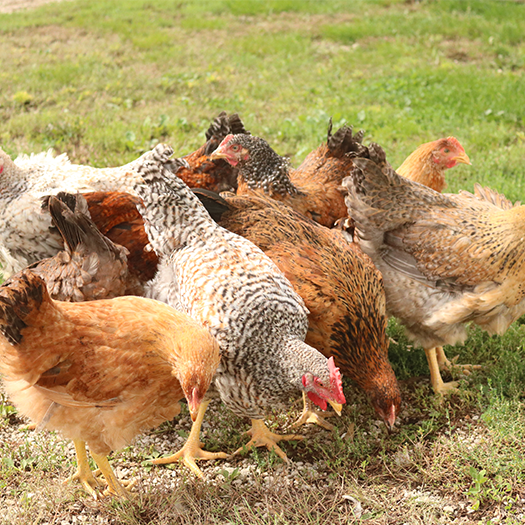Every spring we face a dilemma. It’s tough. We only need to buy five or six pullet chicks from so many different types. So we study the Hoover’s Hatchery website to choose breeds to buy at our nearby farm store.
How can we possibly choose the right mix? There are Brahmas, New Hampshire Reds, Wyandottes, Orpingtons, Sussex, hybrids and a dizzying array of other appealing breeds. We’d like to buy one chick of every breed, but that won’t work. Our coop is small.
Part of our decision is easy. We like large bodied calm brown egg laying hens, so we scratch Leghorns and other white egg breeds off our list. That still leaves dozens of brown egg layers to choose from. Any would fit our needs but we must whittle choices down to a half dozen.

We always create a rainbow flock to add fun with our chicken hobby. Diversity is the key. A rainbow flock includes breeds that look different from each other. So, every year we buy one each of distinctly different feathered breeds.
For example in one year we’ll buy one chick that grows red feathers, like a Rhode Island Red, one that has black feathers, like an Australorp, a mostly white feathered Delaware, a feather legged Brahma, and a gorgeous Silver Laced Wyandotte with contrasty patterned feathers.
Every year our order is different but it always has a mix of different looking chickens. That helps us have fun with our flock.
Rainbow Fun
Every hen in our flock is distinctive and easy to identify. Like people, hens are individuals. Being able to easily tell one bird from the others adds to our chicken fun. The Rhode Island Red in our current flock, for example, is an early riser. She’s always the first girl off the roost in the morning, while our Australorp likes to sleep in. She’s usually the last to leave the roost when the sun comes up. Our Delaware is athletic. She races around the run and seems to love flapping up to her roost for exercise. Our Buff Cochin’s different. She’s content to slowly stroll about and often is the first hen to rest in the shade on a hot sunny day.
If all of our hens were of the same breed and looked nearly identical we’d have a tough time pegging these interesting traits to an individual bird. Seeing these differences is a joy, and sometimes is downright useful.
We’re lucky to work from home, so often we take breaks from our computers and visit the coop during the day. Observation is a great way to learn from our hens and an outstanding way to help children learn.
Backyard Coop Research
A backyard chicken flock can be used to help children learn the basics of scientific research while having a great time. Don’t have a child? These projects are fun for adults. Here is a research project easily done at home with a rainbow flock:
Do hens make friends? Scientists don’t spend time trying to figure this out, but the owner of a small flock can.
Hypothesis: Hens have friends. They like to sleep next to their friends every night.
Equipment needed: A small flock of chickens that don’t look alike and a cell phone.
Procedure: Enter the coop after dark each evening for a week. Bring a cell phone and snap a picture of roosting hens. After a week, compare all seven pictures.
- Does each hen sleep in the same spot on the roost every night?
- Is there a sleep pattern?
- Night after night do the same hens sleep next to the same flockmates?
Conclusion: What is the sleep pattern? Do chickens prefer to sleep near certain “friends”?
Conclusion: Chickens (do/don’t sleep near the same birds each night.
This simple experiment can help a child learn skills in observation, recording data, and drawing conclusions. It’s basic science, but it is also fun. It’s fun to do even without kids!
What conclusions did you draw from your basic research? Please share the results here https://form.jotform.com/253024867453056